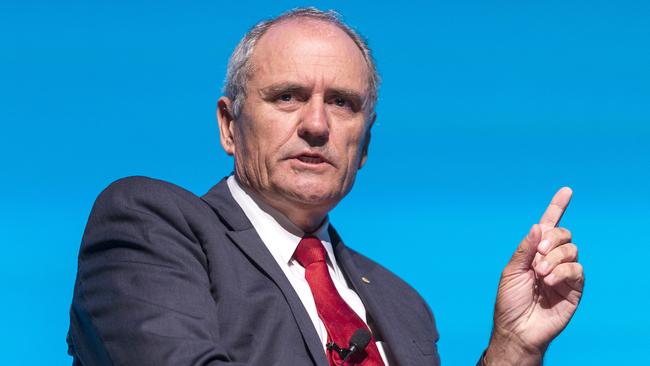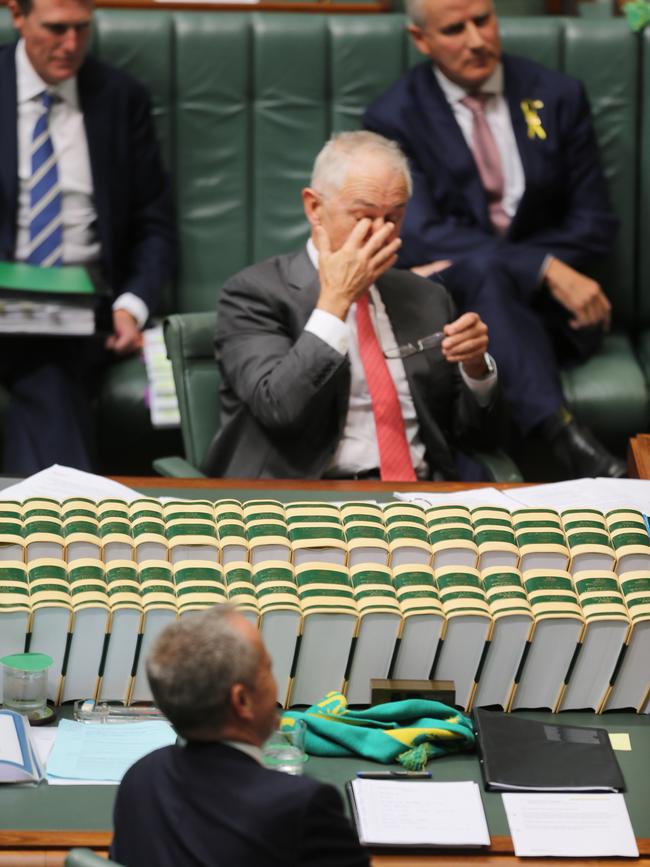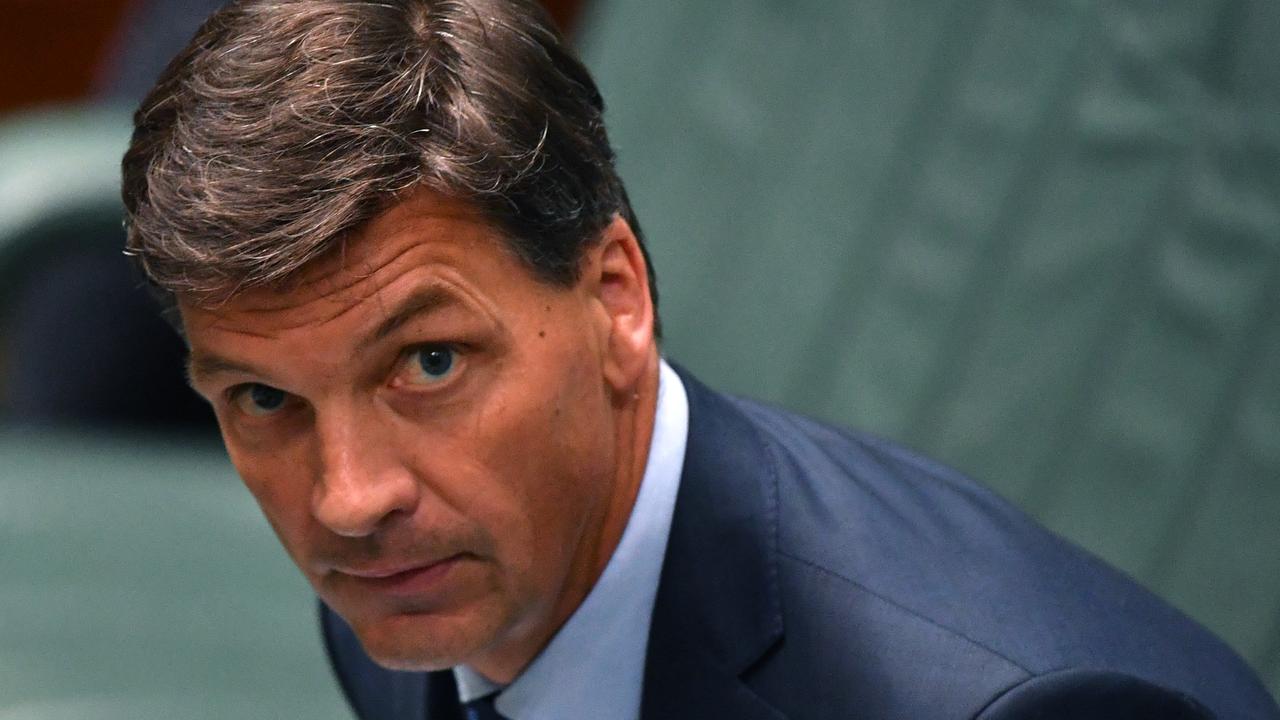Ken Henry says spending surge makes talk of tax cuts absurd
Ken Henry slams the emerging bidding war between the Turnbull government and Labor to cut taxes as “theatrically absurd’’.

Former Treasury secretary Ken Henry has slammed the emerging bidding war between the Turnbull government and Labor to cut taxes as “theatrically absurd” given the rising tide of public spending baked into the budget.
A few weeks after dismissing the increasingly fractious tax debate as “a small set of very narrowly cast propositions”, Dr Henry, speaking to The Australian, took aim at a lack of transparency about the growth of public spending, arguing taxes would need to rise, rather than fall, unless spending was reined in.
Dr Henry, who served as Treasury secretary from 2001 to 2011, said he was “amazed that the issues we observed in 2009 remained completely unaddressed”, referring to the tax system’s inability to meet future spending needs, as laid out in his eponymous 2009 tax review.
“It really has surprised me that there’s been so little discussion about the issues on the expenditure side of the budget,” he said.
Federal spending as a share of GDP has increased from 23.1 per cent in the final year of the Howard government to a projected 25.4 per cent next financial year, powered by health and social security spending, in particular the National Disability Insurance Scheme, the cost of which is budgeted to more than double to $20 billion within three years.
“There remain real questions about adequacy of the unemployment benefit, real questions about the affordability looking ahead for family payments, and real questions about the complexity of our retirement income system, particularly the way the Age Pension interacts with super,” Dr Henry, now the chairman of National Australia Bank, said. “I’m not sure on the right expression but it seems to me absurd, theatrically absurd, that we know we’re going to have to raise taxes but we’re having an argument about which taxes to cut.”

His remarks come as expectations grow that the government will make personal income tax cuts the centrepiece of its May budget. Last week the government narrowly failed to win enough support from crossbenchers to navigate through the Senate its signature plan to cut the company tax rate from 30 to 25 per cent, first announced in the 2016 budget.
Bill Shorten has proposed tax increases and policy reforms that could deliver about $200bn over a decade, which Labor is expected to use to help deliver major tax cuts for low- to middle-income workers. Exclusive modelling for The Australian by Deloitte Access Economics reveals the cuts to personal income tax that would be possible by abolishing family tax benefits. The Deloitte analysis found the middle two income tax rates, which apply to taxable incomes above $37,000 and $87,000, respectively, could be cut from 32.5 to 28 per cent and from 37 to 33 per cent.
The Henry tax review recommended the two payments be combined into one, with a simplified means-test.
Dr Henry acknowledged progress on reform of childcare payments, which collapse into a single streamlined childcare subsidy from July. He was “surprised”, however, that family tax benefits A and B, which provide about $18bn a year to families, hadn’t been reformed.
He also called for a less complex and more consistent eligibility test for the Age Pension, the largest federal outlay, that included at least part of the value of the family home. “At some stage we are going to have to think about including the principal residence to some extent,” he said.
House prices have soared — almost doubling in Sydney — since 2009, when the Henry review estimated about 10,000 age pensioners were living in homes worth more than $1.2 million.
The Parliamentary Budget Office estimates the government’s tax take will rise to the equivalent of 25.5 per cent of national output by 2023, up from 23.2 per cent last year. Thereafter a “tax-to-GDP cap” assumes taxes won’t rise further. In last year’s budget the Turnbull government announced it would lift the Medicare Levy (which is in essence an income tax) by 0.5 percentage points to 2.5 per cent from July 2019, to help pay for the NDIS.
“There’s nothing inevitable about the growth in size of government. It’s a consequence of political choices that have been made,” Dr Henry said.
In the wake of the global financial crisis, federal spending ramped up to 26 per cent of GDP in 2009-10 under the Rudd government, during Dr Henry’s period as Treasury secretary.
Few of the Henry tax review’s 138 recommendations have been implemented. Kevin Rudd’s attempt to adopt one, a mining super-profits tax, precipitated the end of his prime ministership.
“We’ve made things more complex, not less, in the intervening period,” Dr Hentry added.
In a recent speech to the Institute of Company Directors, Dr Henry said the debate about cutting company tax was “the opposite of the sort of discussions we should be having” because it was too narrow.
South Australian senator Tim Storer last week said he would not support the government’s tax plans unless they were part of a broader reform package, like that laid out in the Henry review.
Labor’s plan to cease cash refunds for dividend franking credits and the emerging push for tax cuts has prompted interest in the possible trade-offs between tax cuts and welfare.
The Abbott government’s 2013 Commission of Audit recommended Family Tax Benefit B be abolished, and that part A be significantly curtailed, including a lower payment rate for second and third children to acknowledge economies of scale in child rearing. Family Tax Benefit A is paid to almost 1.5 million families with incomes up to $217,230; B is paid to couples or single parents with incomes up to $127,613.






To join the conversation, please log in. Don't have an account? Register
Join the conversation, you are commenting as Logout